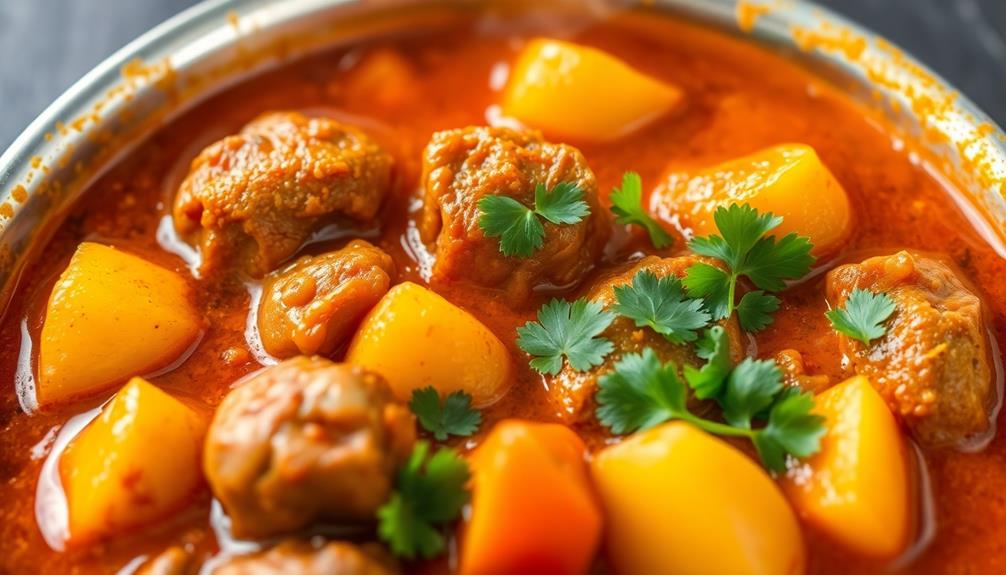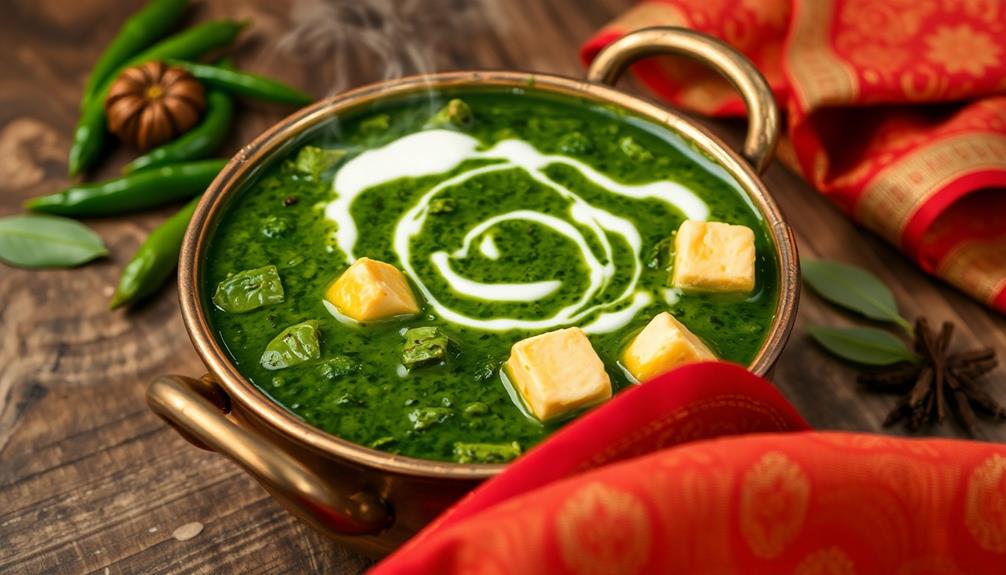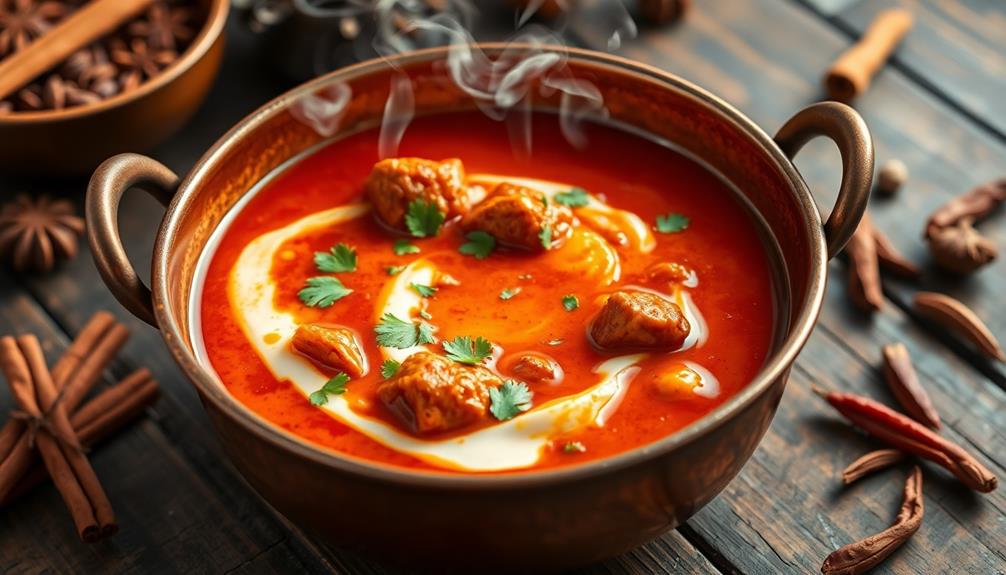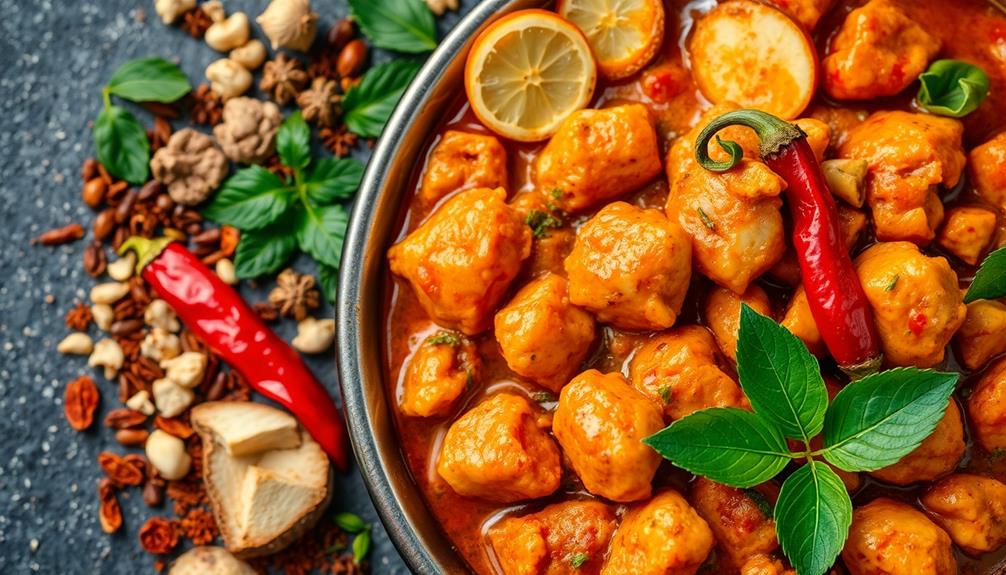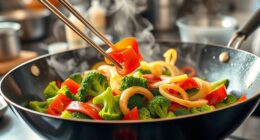If you're looking to wow your friends and family with a bold, flavor-packed dish, you've gotta try Lamb Vindaloo! This spicy, tangy curry hails from the Goa region of India, where Portuguese settlers introduced vinegar and spices centuries ago. The locals put their own spin on it, and now it's a beloved classic. To make it, you'll marinate tender lamb in a fragrant blend of garlic, ginger, and warm spices, then simmer it in a rich coconut milk sauce. Serve it over fluffy basmati rice or with naan bread for the full authentic experience. Your taste buds will be dancing with delight – and if you keep reading, you'll discover even more mouthwatering details!
Key Takeaways
- Lamb Vindaloo is a spicy, tangy, and richly flavored curry dish originating from the Goan region of India during the Portuguese colonial era.
- The dish features marinated lamb cooked with a complex blend of spices, including coriander, cumin, turmeric, chili powder, and black pepper.
- The flavor complexity is achieved through the careful layering of spices and cooking techniques, often resulting in a memorable culinary experience.
- Lamb Vindaloo is typically served with basmati rice or naan bread to soak up the flavorful sauce.
- The dish is celebrated for its ability to impress guests with its vibrant flavors and is popular in Indian restaurants worldwide.
History
Hailing from the Indian state of Goa, lamb vindaloo traces its roots to the 16th-century Portuguese colonial era. The dish's name is a combination of the Portuguese words "vinho" (wine) and "achar" (pickles), reflecting its origins as a Portuguese-influenced curry.
As the Portuguese settled in Goa, they brought with them their culinary traditions, including the use of vinegar and spices to preserve meats. Over time, the dish evolved, with local Goan cooks adapting the recipe to suit their palates.
The result is a boldly flavored curry that features tender lamb, a tangy-spicy sauce, and a unique blend of aromatic spices. Today, lamb vindaloo remains a beloved dish across India and is enjoyed for its robust, complex flavors that transport you to the vibrant streets of Goa.
Recipe
Lamb vindaloo is a spicy, tangy, and richly flavored Indian curry dish that originates from the Goa region. The complex blend of aromatic spices, combined with the tender lamb, creates a truly mouthwatering experience.
To achieve the perfect balance of flavors, it's essential to prepare the spice blend in advance and allow the lamb to marinate for a few hours. This process ensures that the meat absorbs all the wonderful spices, resulting in a depth of flavor that will have your taste buds dancing.
Ingredients:
- 1 lb lamb, cut into 1-inch cubes
- 2 tablespoons vegetable oil
- 1 onion, finely chopped
- 3 cloves garlic, minced
- 1 tablespoon grated ginger
- 2 teaspoons ground coriander
- 2 teaspoons ground cumin
- 1 teaspoon ground turmeric
- 1 teaspoon chili powder
- 1 teaspoon ground black pepper
- 1 teaspoon ground cloves
- 1 teaspoon ground cinnamon
- 1 teaspoon paprika
- 1 teaspoon salt
- 1 cup water or broth
- 2 tablespoons white vinegar
- Chopped cilantro for garnish
Instructions:
In a large bowl, combine the lamb, 1 tablespoon of the vegetable oil, garlic, ginger, and all the spices. Mix well, cover, and let marinate in the refrigerator for at least 2 hours, or up to 24 hours.
Heat the remaining 1 tablespoon of vegetable oil in a large skillet or Dutch oven over medium-high heat. Add the onion and sauté until translucent, about 5 minutes.
Add the marinated lamb and its spices and cook, stirring occasionally, until the lamb is browned on all sides, about 8 to 10 minutes.
Pour in the water or broth and vinegar, and bring the mixture to a boil. Reduce the heat to low, cover, and simmer for 45 to 60 minutes, or until the lamb is very tender. Taste and adjust seasoning as needed.
Serve the lamb vindaloo hot, garnished with chopped cilantro. Accompany it with basmati rice or naan bread for a complete and authentic Indian dining experience.
Cooking Steps
First, you'll need to marinate the lamb in a tangy, spiced vinegar mixture.
Then, sauté the fragrant aromatics in an aromatic oil blend.
Step 1. Marinate Lamb in Spiced Vinegar

The vinegar-marination process is the linchpin of this dish, infusing the lamb with a tantalizing blend of aromatic spices.
Start by combining the vinegar, garlic, ginger, chili peppers, coriander, cumin, and a touch of sugar in a large bowl. Give it a good stir to dissolve the sugar.
Now, add the lamb chunks and make sure they're evenly coated in the spiced vinegar mixture. Cover the bowl and let it sit in the fridge for at least 4 hours, or even overnight if you have the time. The longer you marinate, the more flavor the lamb will soak up.
When you're ready to cook, simply remove the lamb from the marinade and discard the leftover liquid. Your lamb is now infused with mouth-watering flavor, ready to be transformed into a mouthwatering Lamb Vindaloo! Doesn't that sound delicious?
Step 2. Sauté Aromatics in Spiced Oil
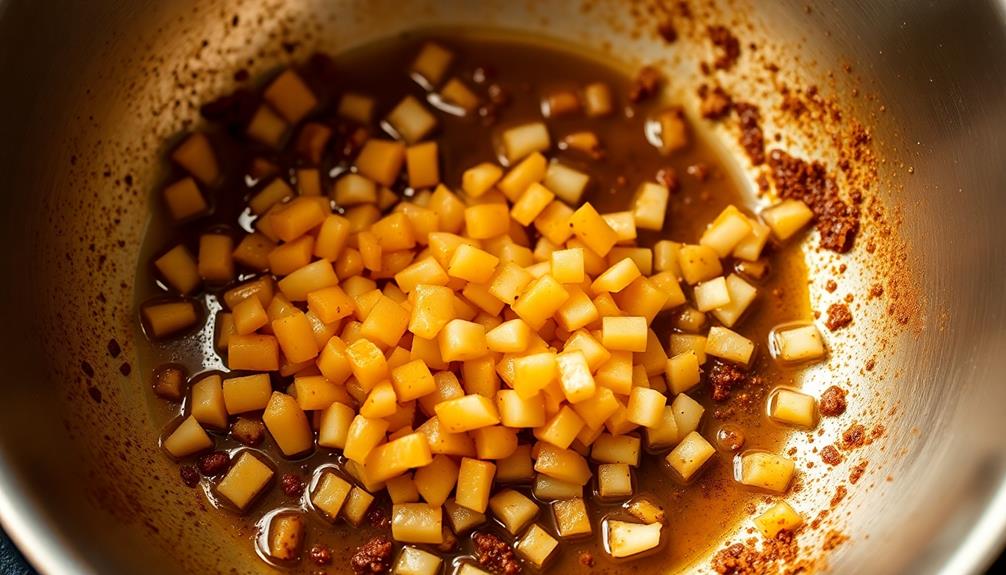
Next, you'll want to sauté the aromatic ingredients in a spiced oil to build the foundation of flavor for your Lamb Vindaloo. In a large skillet over medium-high heat, add a few tablespoons of oil that you've infused with whole spices like cumin, coriander, and cloves.
Once the oil is shimmering, toss in some finely chopped onions, garlic, and ginger. Let these sizzle and soften for a few minutes, stirring occasionally, until they're nice and fragrant.
Now, add in your blend of aromatic spices – things like turmeric, paprika, and cayenne. Give everything a good stir to coat the onions and let the spices toast for about a minute, releasing their amazing aroma.
This step is crucial for developing the deep, complex flavors that will make your Lamb Vindaloo so mouthwatering. Once the aromatics are sizzling and infused with spice, you're ready to move on to the next stage of the dish.
Step 3. Add Diced Tomatoes

Now, add the diced tomatoes to the aromatic mixture. They'll bring a lovely, bright flavor to the dish.
Don't be afraid to add a bit more than the recipe calls for – tomatoes are the perfect complement to the spices in this vindaloo. Stir everything together until the tomatoes are well-incorporated.
You'll notice the sauce starting to thicken up as the tomatoes release their juices. That's exactly what you want! The tomatoes will help create a rich, velvety texture that'll be so satisfying.
Keep cooking for a few more minutes, stirring occasionally, until the sauce has reached your desired consistency. The tomatoes should be nice and tender, but still hold their shape.
With the aromatics, spices, and now the tomatoes, your kitchen must smell absolutely amazing! Get ready for layers of flavor in every bite.
Step 4. Add Coconut Milk

After allowing the tomatoes to simmer and thicken the sauce, it's time to stir in the coconut milk. This creamy addition will give your Lamb Vindaloo a wonderfully rich and silky texture.
Simply pour in the full-fat coconut milk and gently incorporate it into the flavorful tomato base. The coconut milk will meld with the spices, creating a harmonious blend of tastes that'll have your taste buds dancing.
Stir continuously until the sauce is smooth and well-combined. This step helps the coconut milk fully incorporate, ensuring each bite is infused with its luxurious creaminess. The coconut milk will also temper the heat of the chili peppers, balancing out the flavors for a truly delectable curry.
Go ahead and give it a taste – you'll be amazed at how the addition of coconut milk transforms this dish into something truly special. Enjoy every last spoonful!
Step 5. Simmer Until Lamb Is Tender
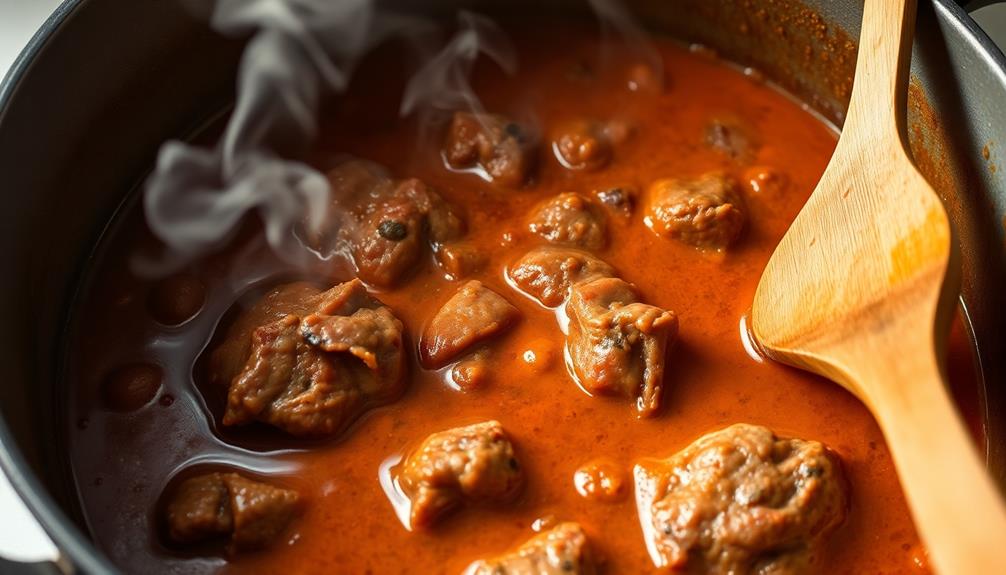
With the coconut milk incorporated, it's time to let the lamb simmer until it's meltingly tender. Keep the heat at medium-low and let the lamb gently bubble away, stirring occasionally.
As the minutes tick by, you'll start to notice the meat becoming more and more fork-tender. That's exactly what you want! The longer you let it simmer, the more the flavors will meld together into a rich, delicious sauce.
Don't be tempted to rush this step – patience is key. You want the lamb to have plenty of time to become super soft and succulent. Give it at least 45 minutes, but up to an hour for the best results.
That low and slow cooking is what'll make the meat practically fall apart when you take a bite. Just keep an eye on the pot, adding a splash of water if the sauce starts to get too thick.
Soon you'll have an irresistibly tender, flavor-packed lamb vindaloo!
Final Thoughts
The Lamb Vindaloo dish is a memorable and flavorful experience that showcases the perfect balance of spices and tenderness.
Now that you've followed the steps to simmer the lamb until it's deliciously tender, it's time to savor the final result. The complex blend of aromatic spices, tangy vinegar, and succulent lamb will tantalize your taste buds.
Don't be afraid to add a bit more heat if you like things spicy – the vindaloo is meant to pack a punch! As you take your first bite, you'll be transported to the vibrant streets of India.
Pair it with basmati rice or naan bread to soak up every last drop of the incredible sauce. This dish is sure to impress your family and friends.
With its bold flavors and tender texture, the Lamb Vindaloo is a true culinary delight that will leave you craving more. Enjoy the fruits of your labor and savor every moment of this amazing meal.
Frequently Asked Questions
Is Lamb Vindaloo Suitable for Vegetarians?
No, lamb vindaloo isn't suitable for vegetarians.
Lamb vindaloo is a traditional Indian curry dish that contains lamb, which is a type of meat.
Vegetarians avoid eating any kind of meat, including lamb.
So, if you're a vegetarian looking for a tasty curry, you'll need to choose a meat-free option like chana masala or palak paneer instead.
These vegetarian curries are just as delicious and spicy as lamb vindaloo, but they don't contain any animal products.
What Is the Origin of the Vindaloo Spice Blend?
You're curious about the origin of the vindaloo spice blend, aren't you?
Well, let me tell you – it's got a pretty interesting history! The vindaloo blend actually comes from the Portuguese word "vinha d'alhos," which means "wine with garlic." The dish has its origins in the Portuguese dish carne de vinha d’alhos, which was marinated in wine and garlic. When the Portuguese introduced this dish to India, the locals added their own twist by incorporating local spices and chilies, resulting in the spicy vindaloo recipe we know today. It’s become a popular dish in Indian cuisine, known for its fiery heat and rich, tangy flavor.
This tasty mix of spices was first used in the Indian state of Goa, where Portuguese settlers introduced it.
So vindaloo has global roots, blending Portuguese and Indian flavors in a delicious way.
Isn't that cool?
Can Lamb Vindaloo Be Made With Other Types of Meat?
You sure can! Vindaloo is a spicy curry that originated in India, and it's quite versatile.
While lamb is a classic choice, you can absolutely make vindaloo with other types of meat like chicken, beef, or even vegetables.
The key is to use the same aromatic spices and tangy vinegar that give vindaloo its signature flavor.
How Long Does Lamb Vindaloo Typically Take to Prepare?
Preparing a delectable vindaloo dish typically takes some time, but it's well worth the effort!
You'll generally need about 1-2 hours to marinate the meat, blend the spices, and simmer everything together to perfection.
Don't worry – the end result is a mouthwatering, tangy, and perfectly spiced meal that'll have your taste buds dancing.
Is Lamb Vindaloo a Common Dish in Indian Restaurants?
Absolutely! Lamb vindaloo is a staple dish in many Indian restaurants.
This flavorful curry is a popular choice for those who love a little spice in their lives. With its tender lamb, bold spices, and tangy vinegar notes, it's no wonder it's such a hit!
Whether you're a vindaloo veteran or trying it for the first time, you're sure to enjoy the delightful dance of flavors in this classic Indian dish.
